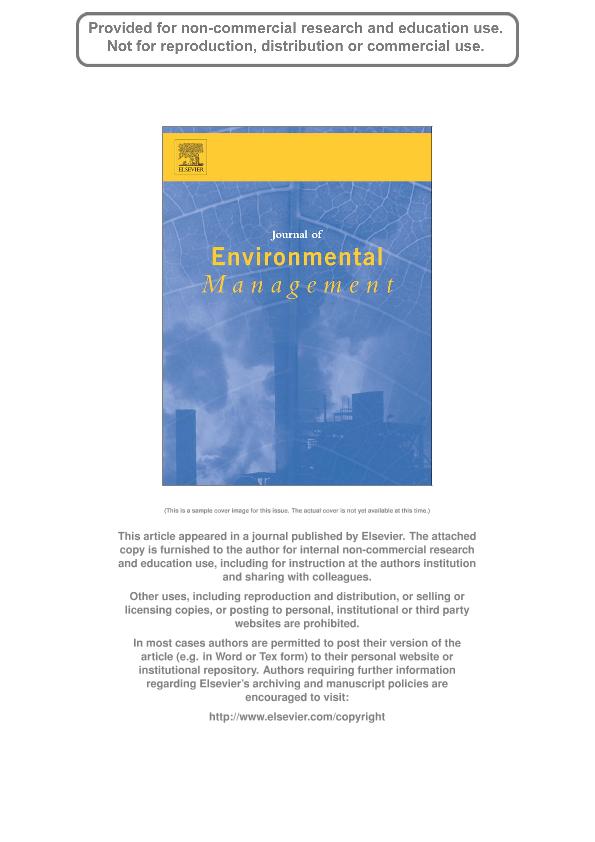Mostrar el registro sencillo del ítem
dc.contributor.author
Chalon, Miriam Carolina

dc.contributor.author
Terán, Victoria

dc.contributor.author
Arena, Mario Eduardo

dc.contributor.author
Oliszewky, Ruben
dc.contributor.author
Gonzalez, Silvia Nelina

dc.date.available
2016-08-04T19:34:55Z
dc.date.issued
2013-03
dc.identifier.citation
Chalon, Miriam Carolina; Terán, Victoria; Arena, Mario Eduardo; Oliszewky, Ruben; Gonzalez, Silvia Nelina; Microbiological culture broth designed from food waste; Elsevier; Journal of Environmental Management; 115; 3-2013; 1-4
dc.identifier.issn
0301-4797
dc.identifier.uri
http://hdl.handle.net/11336/6937
dc.description.abstract
The current trend of increasing air, water, and soil pollution is, in part, due to inadequate management of municipal solid waste (MSW). The relationship between public health and the collection, storage and improper disposal of solid waste has encouraged several studies and the results were attributed to the spread of over twenty human and animal diseases due to this interrelationship. The term single cell protein (SCP) refers to microbial biomass used as a dietary additive. It has high nutritional value because of its high content of vitamins, lipids, and proteins of biological quality (the presence of all essential amino acids) (Lal, 2005). The aim of this work was to design a culture media for microbiological assays and to produce SCP for animal feeding, using nutrients contained in organic waste. In order to compare the effectiveness of food waste (FW) and LAPTg media, different strains of Lactobacillus, Enterococcus, Staphylococcus, Shigella, Salmonella, Saccharomyces and Schizosaccharomyces were studied. In all cases, the growth obtained from FW and LAPTg culture media were not significantly different (p > 0.05). In addition, the growth of Saccharomyces cerevisiae was studied in order to produce SCP for animal feeding. Comparative experiments involving molasses broth, FW broth, and basal broth were carried out. The biomass yield calculated at 24 h from FW broth was 13% lower than from molasses broth. The FW broth provided a significantly lower biomass yield; however, it can be very useful in areas where molasses are not available. FW broth can be elaborated at low cost, in any populated region of the world because its ingredients are wastes generated by humans. It has great versatility, allowing the development of a wide variety of microorganisms, both Gram negative and Gram positive bacteria as well as yeasts. The production of safe protein additives, with high biological quality and low cost, is necessary due to the increasing global demand for food for humans and animals.
dc.format
application/pdf
dc.language.iso
eng
dc.publisher
Elsevier

dc.rights
info:eu-repo/semantics/openAccess
dc.rights.uri
https://creativecommons.org/licenses/by-nc-nd/2.5/ar/
dc.subject
Food Waste Broth
dc.subject
Single Cell Proteins
dc.subject
Bacterial Growth
dc.subject
Microbial Biotechnology
dc.subject.classification
Bioremediación, Diagnóstico Biotecnológico en Gestión Medioambiental

dc.subject.classification
Biotecnología del Medio Ambiente

dc.subject.classification
INGENIERÍAS Y TECNOLOGÍAS

dc.title
Microbiological culture broth designed from food waste
dc.type
info:eu-repo/semantics/article
dc.type
info:ar-repo/semantics/artículo
dc.type
info:eu-repo/semantics/publishedVersion
dc.date.updated
2016-07-25T19:29:58Z
dc.journal.volume
115
dc.journal.pagination
1-4
dc.journal.pais
Países Bajos

dc.journal.ciudad
Amsterdam
dc.description.fil
Fil: Chalon, Miriam Carolina. Consejo Nacional de Investigaciones Científicas y Técnicas. Centro Científico Tecnológico Tucumán; Argentina
dc.description.fil
Fil: Terán, Victoria. Consejo Nacional de Investigaciones Científicas y Técnicas. Centro Científico Tecnológico Tucumán. Centro de Referencia para Lactobacilos (i); Argentina
dc.description.fil
Fil: Arena, Mario Eduardo. Consejo Nacional de Investigaciones Científicas y Técnicas. Centro Científico Tecnológico Tucumán. Instituto de Quimica del Noroeste; Argentina. Universidad Nacional de Tucumán. Facultad de Bioquímica, Química y Farmacia; Argentina
dc.description.fil
Fil: Oliszewky, Ruben. Universidad Nacional de Tucumán. Facultad de Agronomía y Zootecnia; Argentina. Consejo Nacional de Investigaciones Científicas y Técnicas. Centro Científico Tecnológico Tucumán; Argentina
dc.description.fil
Fil: Gonzalez, Silvia Nelina. Universidad Nacional de Tucumán. Facultad de Bioquímica, Química y Farmacia; Argentina. Consejo Nacional de Investigaciones Científicas y Técnicas. Centro Científico Tecnológico Tucumán; Argentina
dc.journal.title
Journal of Environmental Management

dc.relation.alternativeid
info:eu-repo/semantics/altIdentifier/doi/http://dx.doi.org/10.1016/j.jenvman.2012.10.005
dc.relation.alternativeid
info:eu-repo/semantics/altIdentifier/doi/10.1016/j.jenvman.2012.10.005
dc.relation.alternativeid
info:eu-repo/semantics/altIdentifier/pmid/23220651
dc.relation.alternativeid
info:eu-repo/semantics/altIdentifier/url/http://www.sciencedirect.com/science/article/pii/S0301479712005099
Archivos asociados
